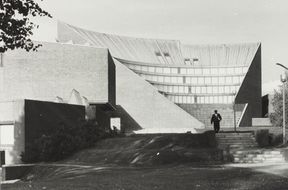Public defence in Engineering Physics, M.Sc. (Tech) Andreas Holm

When
Where
Event language(s)
Title of the doctoral thesis: Role of hydrogenic molecules in fusion-relevant divertor plasmas
Thermonuclear fusion is a promising means for abundant, carbon-dioxide free energy production. The prospective fusion fuel, heavy hydrogen isotopes, can be extracted from seawater and bred from lithium. Energy is produced by fusing light elements into heavier elements, releasing energy in accordance with the principle of mass-defect. In thermonuclear fusion, the hydrogen isotopes are supplied with sufficient thermal energy to overcome the Coulomb barrier and bring the nuclei within sufficient proximity to undergo fusion. The thermal energy required is in the range of millions of degrees and results in the hydrogen fuel existing as a fully ionized gas, as a plasma. The tokamak concept suspends the charged plasma in a toroidal vacuum vessel using magnets and an induced plasma current to control plasma-wall interaction, which is detrimental to the fusion yield. To separate the plasma-wall interaction from the burning core, a figure-eight magnetic topology is applied with magnetic field lines that terminate at the divertor targets, which are specifically designed to sustain the plasma heat loads. The divertor plasma conditions and heat fluxes are strongly dependent on the local recycling cycle of plasma into atoms and molecules at the divertor targets.
A collisional-radiative hydrogenic molecular fluid model, well suited for collisional fusion-relevant divertor plasmas, has been developed and implemented in the fluid plasma code UEDGE. The model enables self-consistent assessment of molecular target heat loads and the role of complex molecular reaction chains on the divertor plasma conditions and heat loads. UEDGE simulations using the novel molecular model are indicative of molecularly induced plasma power losses playing a role in reducing the plasma heat loads to the divertor targets. Sufficient agreement for the fluid molecular model with the kinetic molecular model EIRENE was achieved to warrant application of the UEDGE fluid molecular model for fusion-relevant divertor conditions, which will reduce the computational time of fusion plasma simulations. Furthermore, the work highlights the role of the collisional-radiative processes considered by the molecular models on the molecular densities and molecularly induced plasma power and particle sinks and sources.
Opponent is Professor Ursel Fantz, Max-Planck-Institut für Plasmaphysik, Germany
Custos is Professor Mathias Groth, Aalto University School of Science, Department of Applied Physics
Contact details of the doctoral student: andreas.holm@aalto.fi
The public defence will be organised in Otaniemi (Otakaari 1, lecture hall M1).
The dissertation is publicly displayed 10 days before the defence in the publication archive Aaltodoc of Aalto University






